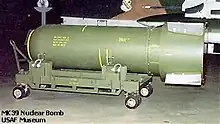Mark 39 nuclear bomb
The Mark 39 nuclear bomb and W39 nuclear warhead were versions of an American thermonuclear weapon, which were in service from 1957 to 1966.

.jpg.webp)
The Mark 39 design was a thermonuclear bomb and had a yield of 3.8 megatons. It weighed 6,500–6,750 pounds (2,950–3,060 kilograms),[1] and was about 11 feet, 8 inches long (3.556 meters)[1] with a diameter of 2 feet, 11 inches (88.9 centimeters).[1] The design is an improved Mark 15 nuclear bomb design (the TX-15-X3 design and Mark 39 Mod 0 were the same design). The Mark 15 was the first lightweight US thermonuclear bomb.
The W39 warhead is 35 inches (89 cm) in diameter and 106 inches (270 cm) long, with a weight of 6,230 pounds (2,830 kg) to 6,400 pounds (2,900 kg). It was used on the SM-62 Snark missile, PGM-11 Redstone short-range ballistic missile, and in the B-58 Hustler weapons pod.
Variants

Mark 39 Mod 0
The Mark 39 Mod 0 bomb was an offshoot of proposals to improve the Mark 15 nuclear bomb. The Mk 39 Mod 0 differed from the Mark 15 in that it used contact fuzes instead of proximity fuzes, and it had thermal batteries instead of nickel-cadmium batteries. It also weighed about 1,000 pounds (450 kg) less. It had a true contact-burst capability along with a barometric fuze option for airbursts that could be chosen in flight (with the contact-burst serving as a backup capability in that case). It had an in-flight insertion (IFI) system.[2]
Mark 39 Mod 1
The Mark 39 Mod 1 notably used a boosted, sealed-pit core, eliminating the IFI system. This "reduced weapon weight, lowered power requirements, and resulted in the use of smaller and lighter batteries." It also was adaptable into a warhead (the W-39) which would eventually be adaptable to a B-58 Hustler external weapons pod, the SM-62 Snark missile, and the PGM-11 Redstone missile. As the weapon now always contained all components needed to fire it, several safety systems were added to avoid inadvertent detonation, including safing pins that would hold in the arming rods, arming rods that required considerable force to pull, and a high-voltage safing switch to prevent detonation in the event that fire or extreme heat igniting the high-voltage batteries.[3]
The pit of the "primary" stage of both Mark 39 Mods 1 and 2 was entirely made of enriched uranium ("all-oralloy") and known as VIPER II. Test "Lacrosse" of Operation Redwing was of this primary system and yielded 40 kilotons.[4]
Mark 39 Mod 2
The Mark 39 Mod 2 was initially pursued with the goal of providing the Mod 1 with a low-level (laydown) release capability, where the weapon would "detonate some time after the weapon struck the target and came to rest". Work was initially done on creating a new parachute system, and the weapon system was initially called to Mark 39 Mod 1 Big Tail. Difficulties arose that necessitated reworking the parachute arrangement as well as developing a different contact fuze (as the original piezoelectric crystals would not reliably operate at the relatively low impact speeds contemplated). A new tail system was developed for the weapon, and it became re-designated as the Improved Big Tail, or the Mark 39 Mod 2 bomb. The new tail used a two-stage parachute: first a 28-foot diameter chute, then a 100-foot diameter chute.[5]
Goldsboro Incident
Two Mark 39 Mod 2 nuclear bombs that were carried by a B-52 Stratofortress broke up in the air and crashed near Goldsboro, North Carolina on January 24, 1961. One of the bombs had its parachute open, and its firing system attempted to go through a normal operation. According to Parker F. Jones, a supervisor of nuclear safety at Sandia National Laboratories, in a 1969 report that was declassified in 2013, the Mark 39 bomb had four safety mechanisms, one of which was not effective in the air. On one of the bombs involved, two more safety mechanisms were "rendered ineffective by aircraft breakup." As a result, Jones noted that the bomb was prevented from detonating only by the fourth mechanism, a simple "ready-safe" electric switch.[6] The other bomb's parachute did not open, and it broke up upon contact with the ground prior to is fuzing system being armed. When its "ready-safe" electrical switch was recovered, it was discovered to apparently be in the "armed" position, however it was later determined that this was only a superficial appearance caused by the damage the switch suffered when the bomb hit the ground, and that electrically it was never in the "armed" configuration. The thermonuclear "secondary" of the second weapon was never recovered.
Survivors
- A Mark 39 casing is on display in the Cold War Gallery of the National Museum of the United States Air Force in Dayton, Ohio. The bomb was received from the National Atomic Museum at Kirtland Air Force Base, N.M., in 1993.
See also
References
- Swopes, Bryan. "Mark 39 Nuclear Bomb Archives". This Day in Aviation. Retrieved 2020-12-01.
- Sandia National Laboratories (January 1968). "History of the MK 39 weapon (SC-M-67-671/RS 3434/20)". pp. 9–10.
- Sandia National Laboratories (January 1968). "History of the MK 39 weapon (SC-M-67-671/RS 3434/20)". pp. 4, 11.
- Hansen, Chuck (2007). Swords of Armageddon, version 2. Vol. V. Chukela Publications. p. 14.
- Sandia National Laboratories (January 1968). "History of the MK 39 weapon (SC-M-67-671/RS 3434/20)". pp. 16–18.
- Pilkington, Ed (September 20, 2013). "US nearly detonated atomic bomb over North Carolina – secret document". The Guardian. London. Retrieved September 20, 2013.